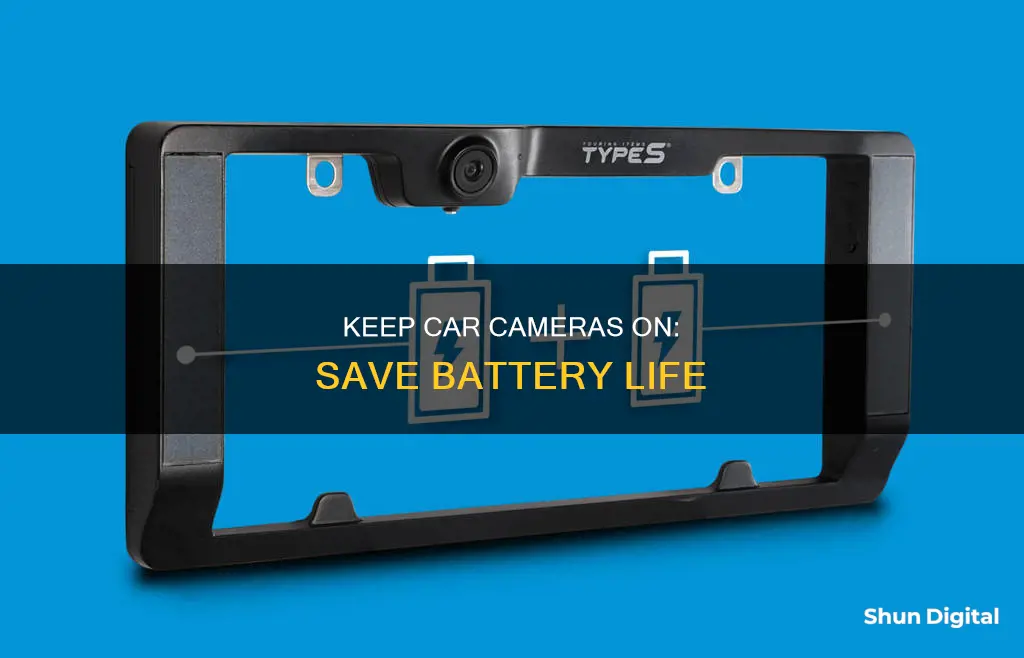
Keeping a camera on in your car can drain the battery, especially if it's not hardwired or connected to an external power source. However, there are ways to prevent this from happening. Firstly, you can use a dedicated battery pack to power your dashcam, which charges when you drive and powers your camera when the ignition is off. Alternatively, you can hardwire your dashcam to your vehicle's fuse panel using a 3-wire hardwiring cable, ensuring the camera can monitor your vehicle's battery voltage level and regulate power to avoid draining it. Another option is to use a Parking Mode hardwiring kit, which regulates power to avoid draining the battery when your car is parked. Finally, ensure your dashcam is connected to a constant power source and not the ignition switch, so it doesn't drain power when the car is off.
| Characteristics | Values |
|---|---|
| Dash cam power source | Car battery, cigarette lighter, USB port, dedicated dash cam battery pack, hardwiring kit |
| Dash cam power usage | Typically <5 watts when recording, less in Parking Mode |
| Dash cam battery capacity | Larger battery capacity allows for longer recording times |
| Car battery capacity | Low-capacity car batteries may drain more quickly |
| Car battery health | Old or weak car batteries may drain more quickly |
| Car usage | Short trips or infrequent use may not provide enough time to charge the battery |
| Car accessories | Dash cams, immobilizers, radios, and interior lights can drain the battery when left plugged in |
| Climate | Extreme temperatures can affect dash cam battery performance |
What You'll Learn

Use a dedicated dash cam battery pack
Using a dedicated dash cam battery pack is a great way to keep your camera running without draining your car battery. This is especially useful if you want to use the parking mode feature, which allows your dash cam to detect motion or impact when your car is parked and turned off.
A dash cam battery pack is a compact, rechargeable power source designed to extend the power of your dash cam. It draws power from your vehicle while driving and then discharges that power to the camera once parked. This process is fully automatic and hands-off, so you don't have to worry about turning it on or off. The battery pack provides enough power to run the camera and reserve charge for when you're parked, conveying that information to the camera to go into parking mode.
There are several benefits to using a dash cam battery pack. Firstly, it extends the recording time of your dash cam, providing an average of 25 hours of parking mode, compared to 6-8 hours provided by an average car battery. This is especially useful if you want to monitor your car overnight or while you're away on a trip. Secondly, it protects your vehicle battery by preventing damage to your dash cam and vehicle battery, extending their overall lifespan. Finally, it is a great alternative if you don't want to hardwire your dash cam to your vehicle's fuse box, as the battery pack can connect directly to the vehicle's cigarette socket.
When choosing a dash cam battery pack, consider the capacity, which is usually measured in milliampere-hours (mAh) or watt-hours (Wh). Higher values indicate a greater amount of stored energy. The BlackboxMyCar PowerCell 8, for example, has a large capacity of 96Wh/7500mAh, which can supply an average of 25 hours of parking mode.
To install a dash cam battery pack, simply plug it into your vehicle's cigarette socket or hardwire it to your vehicle's fuse box. When installing, make sure to hide the battery pack in a safe place, such as under the driver's or front passenger's seat, in the trunk, or in the glove box compartment.
Playing 264 Surveillance Footage: A Step-by-Step Guide
You may want to see also

Hardwire your dash cam to your car's fuse box
Hardwiring your dash cam to your car's fuse box is one of the most common installation methods to keep your camera on while also preventing battery discharge. This method allows your dash cam to capture all the important moments, whether you are on the road or parked, and it is also the cleanest install option.
Step 1: Gather Everything You Need
First, you will need to find where the fuse box is located. You can refer to your car's user manual or search for this information online. Note that you may need to remove some of your car's panels or lift a tab to access the fuse box.
Step 2: Locate the Fuse Box
Once you have gathered all the necessary tools, it is time to find the fuse box. Refer to your vehicle's user manual to ensure you are connecting to the proper fuse and understand the fuse's function. The fuse box is typically located under the steering wheel, in the glove box, or in either front footwell.
Step 3: Determine Which Fuse Slot to Use
Not all fuse slots are created equal. Some control critical functions like airbags, stability control programs, and the horn, so you should avoid those. It is generally safer to choose a fuse that controls the radio, cigarette lighter, or sunroof.
Step 4: Connect the Add-a-Fuses to the Hardwire Kit
Typically, the red wire connects to a constant fuse, the yellow to the ignition-switched fuse, and the C-shaped wire is the ground wire. However, some kits may vary, so always follow the labels attached to each cable. Using add-a-fuses and fuse-taps for hardwire installations is recommended, as it provides a more secure and professional-looking installation.
Step 5: Test Your Dash Cam
After connecting all the wires, plug the kit into your dash cam and start your vehicle. Check the viewing angle of your camera to ensure it is positioned correctly. If your dash cam powers on, you can then tidy up any loose cables and secure them with zip ties or electric tape.
Hardwiring your dash cam can be a straightforward process, but it is important to exercise caution when working with your vehicle's electrical system. If you are unsure or uncomfortable with any part of the process, it is always best to consult a professional.
Recovering RAW Camera Files on V20: A Step-by-Step Guide
You may want to see also

Use a dash cam with a built-in voltage monitoring system
Using a dash cam with a built-in voltage monitoring system is an effective way to keep your car's cameras running without draining the battery. This feature, found in certain dash cam models like the BlackVue X series, allows the device to monitor your vehicle's battery voltage level and prevent over-discharge. Here's a detailed guide on this approach:
Understanding Voltage Monitoring:
Dash cams with built-in voltage monitoring, such as the BlackVue X series (DR970X and DR770X), can detect and respond to your vehicle's battery voltage. This feature ensures that the dash cam doesn't drain your car battery below a certain voltage threshold, typically around 12V.
Hardwiring Your Dash Cam:
To utilize the built-in voltage monitoring feature, you'll need to hardwire your dash cam to your vehicle's fuse panel. This process involves connecting the dash cam to the fuse box using a 3-wire hardwiring cable. The three wires correspond to the Ground, Accessory (switched power), and Battery (constant power) connections.
Choosing the Right Dash Cam:
When selecting a dash cam with built-in voltage monitoring, look for models that offer "native Parking Mode." This feature ensures that the dash cam can monitor the battery voltage level even when your vehicle is parked and the engine is off. The BlackVue X series, for example, has native Parking Mode and built-in voltage monitoring.
Alternative Options:
If your chosen dash cam doesn't have a built-in voltage monitoring system, there are other ways to prevent battery drain. You can use a hardwiring kit with a low-voltage cutoff feature, which automatically shuts down the dash cam if the car's battery voltage drops too low. Additionally, you can consider using a dedicated dash cam battery pack or connecting the dash cam to your car's accessory socket, which usually turns off the power when you remove the keys from the ignition.
Final Thoughts:
By selecting a dash cam with a built-in voltage monitoring system and hardwiring it to your vehicle's fuse panel, you can effectively use your car's cameras without worrying about draining the battery. This setup ensures that the dash cam only draws power when necessary and maintains sufficient battery charge for your vehicle's regular operation.
Computer Camera Quality: Why So Poor?
You may want to see also

Choose a dash cam with a low power consumption rate
To keep cameras running without draining your car battery, choosing a dashcam with a low power consumption rate is essential.
Dashcams typically use less than 5 watts when recording, and even less in Parking Mode. However, some dashcams can have a power consumption rate as high as 400-600 mAh in Parking Mode, which can quickly drain your car battery if you don't drive daily.
To avoid this issue, consider the Thinkware U1000, which offers a superb low-power Parking Mode, although it comes at a high price. Alternatively, the BlackVue DR970X 2-Ch dashcam is another option, with a power consumption rate of 4.07 watts in time-lapse mode.
If you're looking for an affordable option, the Blueskysea B1W dashcam (without GPS) has a power consumption rate of 1.7 watts with Wi-Fi on and 1.4 watts with Wi-Fi off, making it one of the lowest power FHD dashcams available.
When choosing a dashcam, be sure to check the power consumption specifications, especially if you intend to use Parking Mode frequently. This will help ensure that your dashcam doesn't drain your car battery, allowing you to keep your camera running without worry.
Understanding Camera's Antishake Mode: How It Works
You may want to see also

Unplug your dash cam when not in use
One of the simplest ways to ensure that your dashcam doesn't drain your car battery is to unplug it when it's not in use. Dashcams are handy for keeping an eye on your car when it's unattended, but they can also be a nuisance if they drain your battery. While some dashcams have a built-in voltage monitoring system or a low-voltage cutoff feature to prevent this, not all do.
Unplugging your dashcam when it's not in use is a straightforward solution. This is especially important if your dashcam is plugged into a cigarette lighter or accessory socket that remains on even when your car is off. By unplugging the dashcam, you can prevent it from drawing power and draining your battery.
However, it's worth noting that some cigarette lighters and accessory sockets are only on when your car is running or when the ignition key is in the "on" position. In these cases, you may not need to unplug your dashcam, as it will automatically turn off with your car.
Additionally, if you're concerned about the potential impact on your car battery, you can consider using a dashcam with a low power consumption rate or a built-in voltage cutoff feature. You can also opt for a dedicated dashcam battery pack, which is charged while you drive and powers your dashcam when the ignition is off.
By taking these precautions, you can ensure that your dashcam doesn't drain your car battery and that you have a reliable source of power for your camera.
Making Pinhole Cameras: A Step-by-Step Guide
You may want to see also
Frequently asked questions
Yes, you can leave your dashcam on without draining your car battery, but it depends on various factors. These include the type of dashcam, how it's connected to your car, and the settings.
Battery-powered dashcams are designed to consume very little power and are a good option to avoid draining your car battery. Ensure you choose a model that can withstand temperature fluctuations, as extreme temperatures can affect performance.
There are several ways to prevent your dashcam from draining your car battery. You can use a hardwiring kit to connect your dashcam to the car's electrical system, ensuring it turns off with the car. Additionally, you can install a dashcam with a built-in voltage cutoff system, which turns off the camera when the car battery voltage drops.
No, when the engine is running, the alternator powers the dashcam, so there is no risk of draining the battery.
If you leave your dashcam plugged into the accessory socket (cigarette lighter), it could drain the battery overnight if it's constantly recording or activated by motion/bumps. Dashcams with a super capacitor or built-in battery can finish recording and shut down gracefully.







